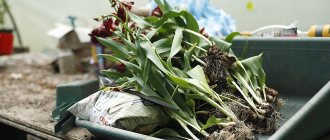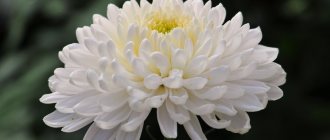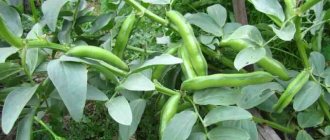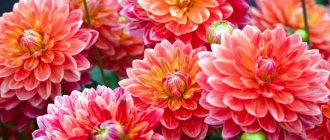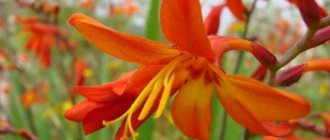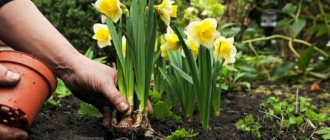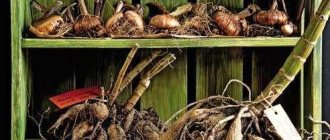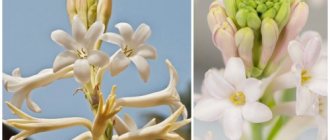Author: Natalya Category: Garden plants Published: March 01, 2018Republished: February 02, 2019Last edits: November 04, 2020
- Growing conditions
- Storage
- Tigridia pavonia
Tigridia (lat. Tigridia) is a genus of herbaceous bulbous perennials of the Iris or Iris family, which according to various sources includes from 20 to 55 species, the range of which extends from Chile and Peru in the south to Mexico in the north. The name of the genus comes from the Latin word tigris (in the genitive case - tigridis) and is translated as “tiger”: the reason for this name, apparently, is the variegated color of the perianth. The Aztecs, who lived in Mexico, grew tigridia as a medicinal plant, using its healing properties. In Europe, tigridia appeared in the 16th century, but it is still rarely found in gardens: apparently, gardeners are confused by the fact that tigridia flowers live no more than 8 hours, opening only in the first half of the day.
Planting and caring for tigridia
- Flowering: from July to September.
- Planting: growing bulbs at home in pots with soil - from the end of March, planting corms in the ground - from the second half of May.
- Digging: in October.
- Storing bulbs: Bulbs are placed for storage only when the above-ground part has completely withered. If frost has occurred and the leaves are still green, dig up the bulbs with a large ball of earth and keep them in a bright, cool room until the above-ground part turns yellow and withers. After this, the bulbs are sorted, disinfected in Maxim solution, dried and stored until spring at a temperature of 3-10 ˚C, immersed in sand or dry peat.
- Lighting: bright sunlight or partial shade.
- Soil: light, loose, well-drained, moderately moist, neutral or slightly alkaline.
- Watering: regular, in drought and heat - daily. The soil is soaked with water to the depth of the bulbs. If the drought drags on, you will have to spray the tigridia in the evenings with warm water.
- Fertilizing: If fertilizers were added to the soil when preparing the site, fertilizing will not be necessary. When grown in unfertilized, poor or depleted soil, make two feedings with a mineral solution per season: a month after the leaves appear and during the budding period.
- Garter: When grown in partial shade, the stems may be too thin, and the plant will need to be tied to a support - a rod or stake.
- Reproduction: seeds, bulbs and children.
- Pests: cabbage cutworms, mole crickets, thrips and slugs.
- Diseases: rot during storage.
Read more about growing tigridia below.
Tigridia flower - planting methods and cultivation
According to botanical characteristics, Tigridia is a perennial flowering plant. Its roots are bulb-shaped and highly dense. It is noteworthy that the tubers of the plant contain a lot of starch and useful substances, so several centuries ago in the homeland of the culture, in North America, these tubers were eaten instead of potatoes.
Figure 1. External features of tigridia
The height of mature plants can reach 70 cm, and the fan of leaves begins to bloom directly above the soil surface. The first buds appear in June, but the flowering period itself can last until the first autumn frosts (Figure 1).
Note: After blooming, the bud will delight you for only 8-10 hours, after which it will fade. Therefore, if you want to create an original flower arrangement based on Tigridia, you need to plant several plants at once.
The bulbs of the crop are quite productive, and during the growing season they can simultaneously produce about 6 flower stalks, each of which contains 2-3 buds, the color of the petals of which differs depending on the variety.
After flowering is complete, a box of seeds is formed in place of the withered buds, which can be collected for further growing of young plants.
Planting tigridia in open ground
When to plant
Since tigridia bulbs react to a sharp cold snap, planting in open ground is carried out only after the threat of return frosts has passed, that is, not earlier than the second half of May. Tigridia should be planted in an open, well-lit area. It also grows in partial shade, but then the flower stalks of the plant will be thinner and weaker, and they will have to be tied to a support. Tigridia does not like drafts and sharp gusts of wind, which break its fragile, thin stems.
The soil for tigridia should be light and loose, well-drained, not acidic and moderately moist. Soil that is too dense should be dug up with sand or sawdust to make it loose.
- Crocuses: growing in the garden, types and varieties
How to plant
Before planting, Tigridia bulbs need to be pickled for 2 hours in a solution of 4 ml of the drug Maxim in 2 liters of water - this treatment will further protect the plants from gray and white rot, fusarium and other diseases.
The depth of planting of bulbs depends on their size. For example, large specimens are immersed to a depth of 10 cm, and small planting material is enough to be buried to a depth of 5 cm. The distance between the bulbs in a row should be at least 15 cm with row spacing of 20 cm. Shoots will appear only after 4-5 weeks, flowering will begin in August, but the plants will not have time to bloom before frost, and this may negatively affect the replacement corms. Therefore, we strongly recommend that before planting in open ground, you grow tigridia bulbs at home, placing them at the end of March for forcing. We will tell you how to do this correctly in the section on transplanting tigridia.
Caring for tigridia in the garden
Growing conditions
Growing tigridia does not require any special procedures. It will be enough to water the plant, loosen the soil around it, remove weeds from the flowerbed, apply fertilizer, and if you cover the surface of the plot with humus or peat to preserve the soil structure, you will have to water, loosen and weed much less often. In addition, you will need to remove faded flowers and, if necessary, install supports for the tigridia in the form of rods or pegs.
Watering and feeding tigridia
Tigridia in open ground needs regular watering, and in dry times - daily, and surface moisture will not do anything, the soil needs to be wetted to the depth of the bulbs. In case of prolonged drought, you will have to spray the ground part of the tigridia with warm water in the evenings.
If fertilizers were added to the soil before planting the bulbs, additional fertilizing during the tigridia growing season will not be needed. To fertilize poor or depleted soil, two fertilizing with a solution of 3 g of complex fertilizer in 1 liter of water per season is enough: a month after the leaves appear and during the formation of buds.
Transfer
In order to speed up the start of flowering of tigridia in open ground, its bulbs are grown at home from the beginning of spring: at the end of March, 3-4 bulbs are planted for forcing in a light substrate, buried so that there is a layer of soil above the bulbs at least 3 cm thick For the first weeks, the substrate in pots is watered moderately, but as soon as the bulbs begin to sprout, they will require intensive moisture: moisture should penetrate the entire depth of the substrate, reaching the roots of the bulbs. To achieve the required level of soil moisture, but at the same time not provoke fungal diseases, the bulbs are planted in pots with wide drainage holes and high stand plates and the bottom watering method is used. When the arrows appear, the pots with forcing are moved to a warm, bright windowsill and protected from drafts. Prepared bulbs are transplanted into open ground in early June.
- The best varieties of white rose
A hole for replanting tigridia is dug to a depth of 50-60 cm. Drainage material made of broken bricks and a layer of horse manure about 20-25 cm thick are laid on its bottom, then a layer of loose soil of the same thickness, on which the sprouted bulbs are laid. The remainder of the hole space is filled with fertile soil. After transplanting, the area is watered.
Reproduction
If tigridia blooms in the second half of July, its seeds have time to ripen before the cold weather. They are collected before frost and sown in winter in a bright room without pre-sowing treatment. Seeds germinate at a temperature of 20-25 ºC. Seedlings do not tolerate root injury well, so they are planted in separate pots along with a ball of earth at the stage of development of the first two true leaves. Tigridias bloom from seeds 6-7 months after sowing.
Tigridia also reproduces vegetatively: in one season, an adult bulb forms up to 5 replacement children, which are separated from the mother corm immediately before planting and, after treating the places of cuts and breaks with crushed coal, they are planted in the ground.
Feeding Tigridia
Fertilizing should be done every two weeks, using complex mineral fertilizer. In addition, foliar feeding of leaves is useful. The supply of nutrients to the plant directly affects the quality of flowering and the formation of strong flower stalks. After flowering, the flowers are removed so that the nutrients of the bulb are not consumed for the formation of seeds. At the end of the season, when the main peduncle fades, the dormant buds of the bulb begin to wake up, which stimulates flowering.
Tigridia in winter
Storage
Due to its heat-loving nature, wintering tigridia in open ground is impossible in most climatic zones: in the fall, plant bulbs are dug up and stored until spring at a low but above-zero temperature. And it is precisely with the extraction from the ground and storage of corms that the difficulties of growing tigridia are associated. The main condition for the normal storage of planting material for this crop is the complete ripening of the bulbs, so it is important to know when to dig up tigridia in the fall. The bulbs can be stored only after the above-ground part of the plant has withered, but if frost is approaching and the leaves on the tigridia are still green, you should dig up the corms with a large earthen lump, bring them into a bright, cool room, wait until the dug-out plant turns yellow and the leaves will wither, and only after this will it be possible to prepare the corms for storage.
Before storing in storage, the planting material must be cleaned, washed, pickled in a solution of the drug Maxim, dried well, but there is no need to separate the children from the mother corms - postpone this procedure until spring. How to store tigridia before planting? The bulbs are immersed in dry peat or sand and kept in a room with normal humidity at a temperature of 3 to 10 ºC. You can put the planting material in paper bags and place it in the vegetable drawer of the refrigerator. During the winter, it is necessary to periodically check the condition of the bulbs in order to detect damage or rotting in time.
Preparing tigridia for winter
Despite the fact that tigridia are perennial plants, the bulbs freeze in open ground at sub-zero temperatures . Therefore, as soon as the above-ground part of the plant withers during frost , the corms are dug up and stored at home until spring. Before storing the bulbs you need to prepare:
- Trim leaves and stems.
- Dry for two weeks at room temperature.
- Shake off any remaining soil.
- Shorten the hemp stems to two centimeters.
- Trim the roots.
- Dry for about two more weeks.
Bulbs ready for storage are covered with dry sand. Wet soil and sand are not suitable for storing them, since tigridia corms unprotected by scales will begin to rot in damp conditions. Bulbs placed in sand should be stored in a dry room with an air temperature of +4 to +10 degrees.
You can store flower planting material in a nylon net at home, hanging it closer to the ceiling.
Two or three weeks before planting the trigridia in open ground, the nests of corms are broken and the broken areas are dried in the children.
Pests and diseases
The biggest problem of tigridia is the death of the bulbs from rot during winter storage. The cause of rot is insufficient ripening of planting material. This is why it is so important to wait for the natural wilting of the above-ground part of the tigridia before placing the bulb in storage. To prevent rotting of the bulbs, they should be pickled in a solution of the drug Maxim or other fungicides, for example, in a solution of Fundazol or Benlat.
In open ground, tigridia can also develop rust or scab. This can be avoided by treating the plant leaf by leaf for preventative purposes with solutions of fungicidal preparations or herbal infusions. But tigridia cannot be saved from mosaic: there is no cure for viral diseases yet, so it is important to maintain the health of the plant with good care.
- Dogwood: cultivation, propagation, types and varieties
Of the pests, the greatest danger to tigridia are cabbage cutworms, mole crickets, thrips and slugs. Cutworms, their caterpillars and thrips are destroyed by treating tigridia on the leaves with insecticidal preparations, which are sold in any garden pavilion or specialty store. You will have to collect the slugs manually, using pieces of slate or boards laid out around the area as traps: on a hot day, the slugs hide under them from the sun, and all you have to do is get them out of the shelter and destroy them. And the mole cricket’s passages need to be filled with soapy water, and if the insect does not die in the depths, but gets to the surface, destroy it.
Diseases and pests
Tigridia is a rather picky plant; diseases can be caused by several factors:
- excessive watering;
- adverse weather conditions;
- poor soil quality;
- improper care.
To prevent the risk of diseases, it is necessary to comply with agrotechnical rules and preventive measures. Corms are treated with fungicides before storage and planting, and treated with antifungal compounds.
An effective and popular folk remedy is mustard infusion. For 10 l. add 10-15 g of mustard powder to water and leave for 24 hours. Affected bulbs must be disposed of.
Among the diseases of tigridia, the most common are:
- Tobacco mosaic. Incurable viral disease. Distinctive features: the appearance of bright multi-colored spots on the foliage, deformed fruits and stems, stunted growth. For preventive purposes, it is recommended to use healthy planting material and disinfection procedures for garden tools and bulbs.
- Rust. The fungal disease manifests itself in bright orange spots on the surface of the leaves and stem parts. Treat the affected plants with Topaz, Vectra, Kuproksat, Strobi, and Flutrivit.
- Scab. The entire plant is affected by the pathogenic fungus. Numerous black spots appear. For preventive purposes, Kuproksat and Fitosporin-M are used.
- Rot. For prevention, flower beds are sprayed with preparations containing copper.
Pests include mole crickets, cabbage cutworms, snails and chafers. For preventive purposes, plants are sprayed with special preparations, pesticides are laid out, and traps are set. Use wood ash effectively. It is sprinkled on the soil around flowers, which repels pests, and at the same time saturates the soil with useful substances.
Types and varieties
Tigridia pavonia
Only one species of the genus is grown in culture - tigridia peacock , which comes from Guatemala and Mexico. The plant can reach a height of 25 to 70 cm. Its irregularly shaped bulb is up to 6 cm long and up to 4 cm in diameter, covered with membranous scales. By the end of the growing season, the old bulb is completely depleted, but new bulbs are formed in its place, forming nests. The number of bulbs practically coincides with the number of scales on the mother bulb. One bulb can form from 3 to 5 peduncles, each of which produces up to 5 buds. The leaves of tigridia peacock are xiphoid, wide, light green, folded along their length. Flowers with a diameter of 10-15 cm from six lobes open alternately. The outer perianth lobes are bright red or violet-orange, the inner ones are much smaller than the outer ones, yellowish-orange spotted in color, like the throat of the flower. Flowering occurs in July and August, each flower lasts only 8-10 hours, with a total flowering period of 15-25 days. Tigridia peacock has several garden forms:
- Alba is a plant with white flowers with red spots:
- Aurea - a form with dark yellow flowers with carmine spots;
- Carminea - tigridia with orange flowers with yellow spots;
- Tigridia Lilacea - a plant with lilac-red flowers with carmine spots;
- tigridia Rosalind - a form with flowers of a soft pink hue;
- Canariensis - tigridia with light yellow flowers and a bright red center;
- Speciosa is a form with scarlet-red flowers in golden-yellow spots.
The variety mixture “Tigridia Ferraria mixed” is also in demand - plants up to 60 cm high with sword-shaped leaves and flowers up to 15 cm in diameter with plain outer petals of red, mauve, orange, white or yellow and three inner petals with elegant spots.
For breeding work, the species used are Tigridia tubularis with pale pink flowers, Tigridia Mexicana with yellow flowers, Tigridia seleriana with bluish-lilac flowers and other species that are not grown independently in cultivation.
Botanical characteristics of Tigridia
Tigridia belongs to the Kasatikov (Iris) family. The subtropics of South America are considered its homeland. It is a perennial herbaceous bulbous plant reaching 30-70 cm in height. Its name translated from Latin means “tiger”. This comparison is most likely due to the variegated color of the perianths.
Unabi - beneficial properties and contraindications, planting and care
Stefanandra - cultivation, planting and care
The root system of Tigridia is a rhizome shaped like a corm, rich in starch and glucose. That is why in many countries Tigridia is grown for its tasty corms, which are eaten, like the well-known Potato.
At the base of the plant a rosette of strap-shaped or sword-shaped dark green leaves is formed, arranged in the form of a fan. The surface of the sheet plate is corrugated. In the center of the leaf rosette there is an erect stem, at the top of which there is a single flower, or 2-3 flowers each having an unusual shape, reminiscent of an exotic, beautiful butterfly. The corolla of the flower, whose diameter is usually 8-10 cm, consists of 3 large outer petals and the same number of small ones. The outer petals are mostly a single color (yellow, red, orange, purple or pink), but the inner or central part is variegated.
The fruit is a seed capsule. The seeds are angular, brown, slightly flattened.
